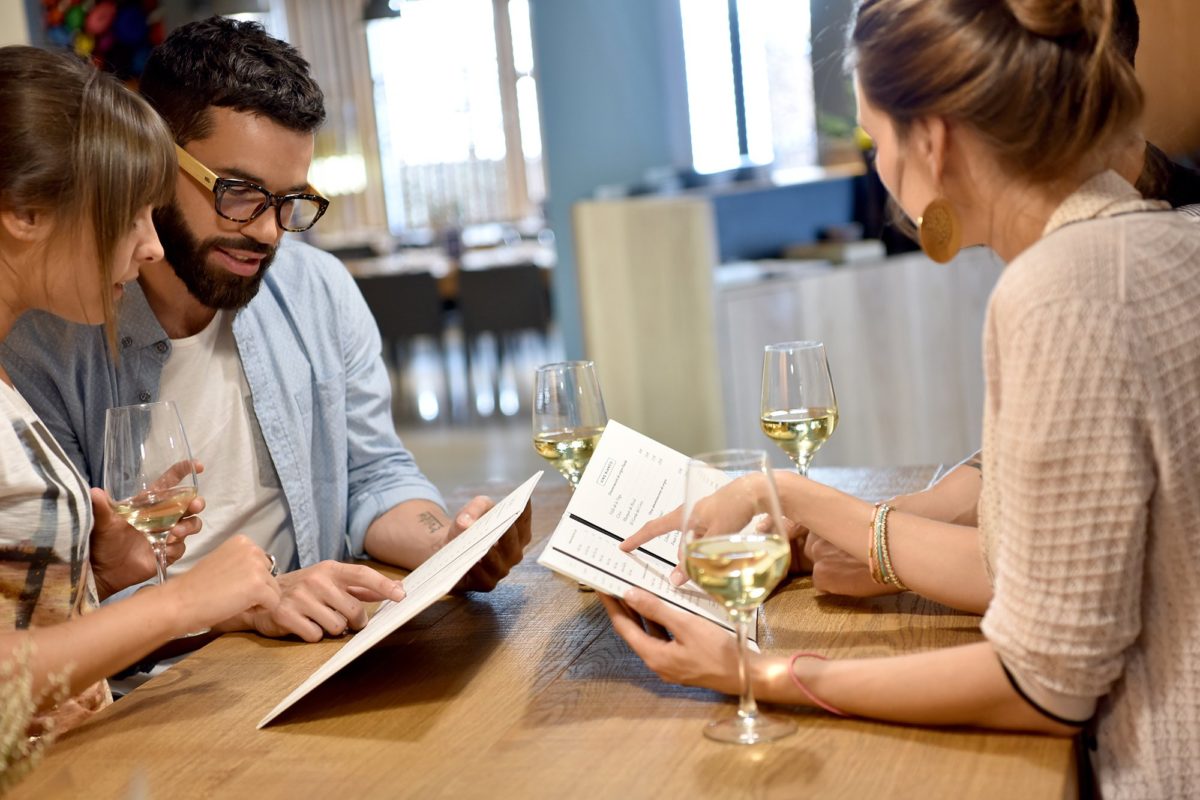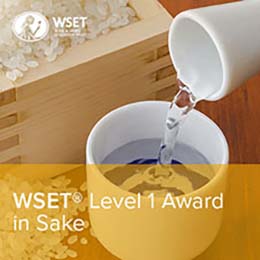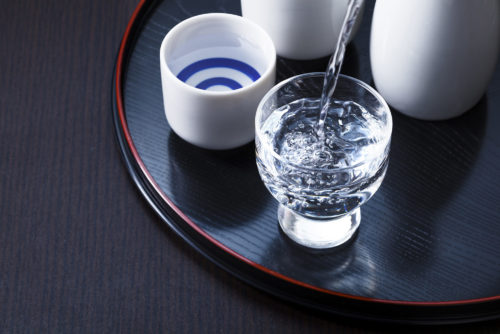
by Adam Chase | Jul 3, 2018
Grape Experience sake expert Marina Giordano’s passion for the Japanese beverage has led her to travel extensively in Japan, studying production in multiple regions with officials of the National Brewery Council. She is a WSET Certified Sake Educator and has earned the Advanced Sake Professional title with the Sake Education Council. She now shares her knowledge for those looking to broaden their understanding of this fascinating (and growing) category.
What first led you to explore Sake?
I was studying wine (the WSET Level 2) when a friend introduced me to sake. I fell in love – I had to learn everything I could about it. I was infatuated with the subtle aromas and flavors. The complexity intrigued me, how could sake taste this way? It’s not even a fruit! I started looking for classes that night.
What has been the highlights of your sake career?
Most of it has been traveling: traveling to Japan to study more about sake and traveling to teach classes and introduce people to sake who had never tasted it before. Maybe even more exciting is seeing the interest in sake grow around the USA. More people are drinking it, asking for it, and sake is appearing on more menus. It still has a long way to go, but it is exciting to see it becoming more popular!
What led you to become a WSET certified sake educator?
The love of teaching. I enjoying helping people to understand something new, whether it is a professional who will take that knowledge to their workplace, or an enthusiast who wants to learn more about sake. It’s great to have students come out of class with a new appreciation (an even a love) for sake.
How does the WSET program compare with other sake programs you have taken?

I think the WSET Sake program is the most comprehensive sake program available. It is created and presented in a clear yet detailed manner. It makes a complicated subject easy to understand. The program is structured so that your knowledge builds as you go into the specifics of production – going in depth about ingredients, production methods, and styles. There are many misconceptions about what sake is. With information from this class, students will get a better understanding of what sake is and how it is produced.
Who is the WSET Sake geared towards?
Both professionals and consumers. Level 1 is great for sales staff who may have sake in their store, bar, or portfolio, or consumers who want more knowledge about what they are drinking and to know what to buy. Level 3 is more in depth in all aspects of sake, but enthusiasts love the course. It is also great for professionals who would like to get a better understanding of sake.
What would you say to someone who is thinking about WSET Sake but wonders if they really need or will use it?
For someone in the industry, these classes will build your confidence and comfort level with sake. It’s a growing segment and any knowledge can be helpful. Consumers will come out with a better understanding of sake, to help them easily select sake off the shelf or list, or they may even discover sake styles they didn’t know existed!

by Adam Chase | Dec 26, 2017
I hear from many people with interest in Grape Experience WSET courses who are unsure where to start or if they want to make the commitment. Those who do take the plunge always feel great about it. If you are thinking you would like to explore WSET Wine, Sake or Spirits education there is no time better than now!
How to Decide Where to Begin:
WSET courses are broken out by “Levels,” and these terms can be confusing. Each level has a specific end goal or learning outcome regardless if it is for Wine, Sake or Spirits. For Wine and Spirits most people have enough knowledge already to skip right to Level 2. Sake is lesser known and Level 1 may make the most sense.
Level 1: Define and Understand
Level 1 focuses on true beginner knowledge. We answer questions such as:
- What is wine or sake?
- What basic styles does it come in – dry, sweet, sparkling, red, white and rosé?
- What is the best way to serve it – temperature, glassware, food pairings
I often say for the wine courses that if you know that Chardonnay is a white grape that makes white wine that should be served chilled, and that Cabernet Sauvignon is usually a red wine, then it might make more sense to start at Level 2.
For Sake, however, Level 1 can be an easy way to start exploring a beverage category that is growing each day. We offer Level 1 Sake a few times each year with the next courses starting this winter WSET Sake Class
Level 2: Identify and Describe
Level 2 is where most WSET wine and spirit candidates start. Courses under Level 2 are also fine as beginner classes but they go into more depth then Level 1. The goal here is for a student to be able to look at any major wine or spirit bottle and describe what is expected inside without having to taste it – that doesn’t mean that we don’t taste in Level 2 classes – we absolutely do and a great component of Level 2 is to build strong foundational tasting skills.
Students who take Level 2 often tell me that their confidence has skyrocketed when it comes to choosing or talking about wines and spirits. I think Level 2 provides a smoother, perhaps less risky entry into the WSET system of courses, even for people with already strong wine knowledge. Our next set of Level 2 courses starts this February: Wine Courses for Beginners
Level 3: Explain
Level 3 is significantly more challenging than Level 2 and demands more study and participation time from the participant. Still, the depth of knowledge and tasting ability that comes from a Level 3 course is totally worth the effort. Level 3 courses do not have prerequisites.
The basic goal of Level 3 courses is for the participant to be able to explain the reasons why a wine or sake looks, tastes, and costs the way/amount it does. This Level deeply delves into natural and human forces that impact production and quality. Tasting plays an equal role to the theory here and students will certainly learn to blindly identify through sight, smell and taste how a wine or sake is made and its ultimate quality Level.
Level 4 Diploma: Analyze
Currently WSET only offers a Level 4 course in Wine and Spirits. This is a two-year program that requires participants first pass the Level 3 Wine course. The goal here is to learn to analyze the natural and human production factors, market trends and new technologies/approaches that are shaping today’s wine and spirit markets.
Participants build skills through first-hand, as well as book investigation into the major global wine and spirits production centers and companies. The course is incredibly challenging but well worth it!
So, there is no time like the present! Check out all of the WSET courses we offer and take the plunge!


by Matthew Gaughan | Oct 23, 2017
This month I took Grape Experience’s WSET Level 1 Sake course. As a wine educator, this was a fascinating experience, as sake is such a different beverage to wine. I learned that the sake language, aroma descriptors, and terminology generally don’t apply to wine (there are more overlaps with whisky and beer).
If you’re coming to sake from a wine background – which most people in the class were – it’s refreshing and stimulating having to think about and describe a quality beverage using a different approach. For instance, I consider acidity to be one of the most important factors to the structure and quality of a wine. In sake, acidity is so low that it’s quite a shock, but once I became accustomed to that low acidity I stopped thinking about it so much.
Another difference is that alcohol is higher than wine (at 15-17% ABV), but there is a surprising delicacy to sake that is often lacking in wines at high levels of alcohol. Despite tasting ten sakes, at the end of the day I felt a freshness that I don’t feel after tasting ten wines. Quite why that is I don’t know, but it was something other students commented on.
Umami aromas (found, for example, in mushrooms, tomatoes, or parmesan cheese) are present in wine, but in sake, especially the honjozo and junmai styles, umami aromas are dominant. This makes sake a good pairing with salty food, as umami and salt flavours complement each other. There’s perhaps no surprise in that as sake and seafood is a classic Japanese food pairing.
Sake, though, has huge potential for food pairing beyond traditional Japanese cuisine. On the course, we tasted two sakes (honjozo and ginjo) with different foods: lemon, tomatoes, crisps, parmesan cheese, honey, and soy sauce. It’s rare to find a drink that can stand up to both tomatoes and honey and the only food that the sake struggled to complement was the lemon, its tart acidity overwhelming the low acidity of the drink. But given that lemons are rarely eaten on their own, I didn’t consider that an issue!
This is a great course which I thoroughly enjoyed. It provides an insight into Japanese culture, an overview of sake, and a good idea of the different styles and how they pair with food. Most importantly, it explains why sake tastes like it does, the reasons behind each style, and is a great help for walking into a shop or a restaurant and knowing which sake to buy and why.
The course was taught by Marina Giordano, who is a colleague of mine at Grape Experience. I can say without any prejudice that she is a great tutor with a thorough knowledge of the WSET and of sake. I walked into the course intrigued by sake; I came out of it enthused and knowledgable. I can’t ask for more than that from any course.

by Matthew Gaughan | Sep 26, 2017
A few years ago, I attended a sake tasting in Manchester in the UK at hangingditch, the wine shop where I was then working. It was a fantastic tasting, featuring many different styles of sake. In its range of styles, diversity of food pairings, and salty, sometimes nutty aromas, I discovered a definite similarity to sherry – which just happens to be one of my favourite drinks.
Sake is a Japanese drink made from rice and at that tasting I learnt about how rice affects the style of sake. Milling, or polishing, the rice is central to the style of sake: the more polished the grain, the more delicate the drink. Furthermore, the type of rice used can change the color as can ageing the sake in oak and sake can have different levels of sweetness.
Sake is also a great drink to pair with food – seabream, octopus, eel, and pork were just some of the foods we tried with the different sakes at the tasting. Pairing the right drink with the right food enhances any meal and the diversity of sake makes it an ideal accompaniment to the small, varied dishes served in Japanese restaurants.
Since then however, I haven’t had the chance to further my knowledge of sake. But sake has continued to intrigue me and now I’m taking the day-long WSET Level 1 Sake course with Grape Experience in San Francisco. I’m looking forward to refreshing my limited knowledge of sake and relearning definitions such as honjozo, daiginjo, and junmai. As with wine, knowing what the terms on a label mean allows you to understand the style of sake. Visiting a Japanese restaurant will be a much more rewarding experience as I will be able to choose the ideal sake to pair with the food I’m eating.
I’m also finally going to get to meet Marina Giordano, a fellow Grape Experience Certified Educator whose knowledge of and enthusiasm for sake can be found on twitter and instagram.
The course is on Sunday, 1 October at Roka Akor, 801 Montgomery Street, San Francisco, from 9:00AM-5:00PM with a short multiple choice exam later in the month. You can enroll at WSET Sake Class here.
Matthew Gaughan is a WSET Certified Educator who teaches for Grape Experience and completed the WSET Diploma with Grape Experience.

by Adam Chase | Sep 7, 2016
How is sake made? Is it distilled? Brewed? Is it more like wine or spirits? Should I drink it warm? Cold?
Sake is a complex alcoholic drink that is gaining more attention in the US. More and more people are seeking out this ancient beverage – Would you like to learn more about sake?
Grape Experience is excited to announce we will be launching the new WSET Level 1 Certificate in Sake this fall. This new course is an introduction to sake and will answer these questions about sake and more!
As an introductory course it is intended to introduce production, ingredients, grades and styles of sake. It is designed for both consumers and professionals.
This course is great for sake enthusiasts who would like to learn about sake but aren’t ready to commit to the in-depth study of our Level 3 Certification. For industry professionals it is an excellent introduction to the growing category of sake, providing the knowledge you need to sell sake.
Learn how production methods can influence the style and category of premium and specialty sake. We’ll taste through various samples to demonstrate the complexity of this diverse beverage. Included in the course is a section on service and storage of sake, an important part of enjoying sake!
We will be offering this course in San Francisco this fall and in Boston in 2017. Level 1 Certificate in sake will provide a solid understanding of sake before continuing on to our Level 3 Sake Certificate. To enroll just click here: WSET Sake Class







